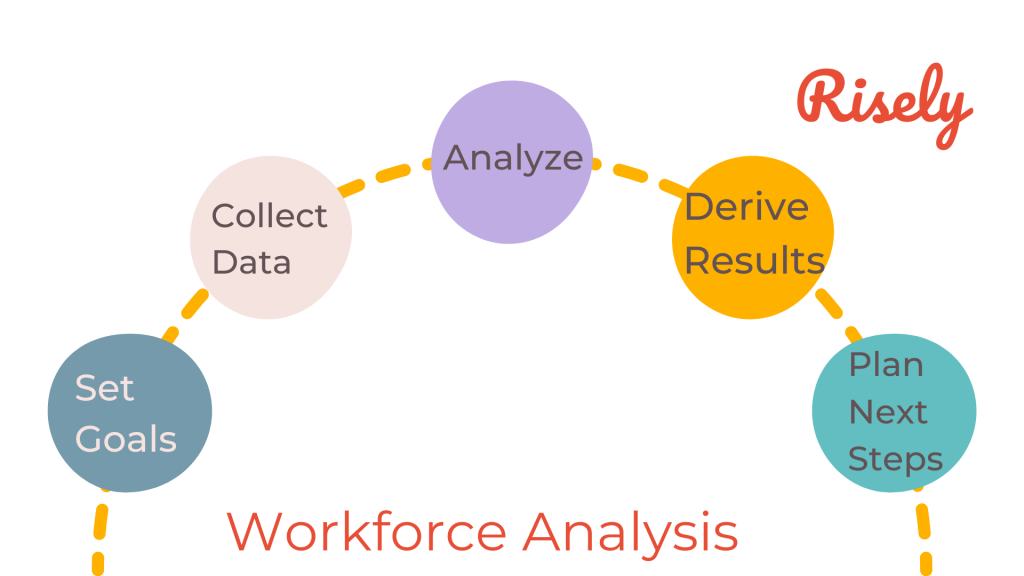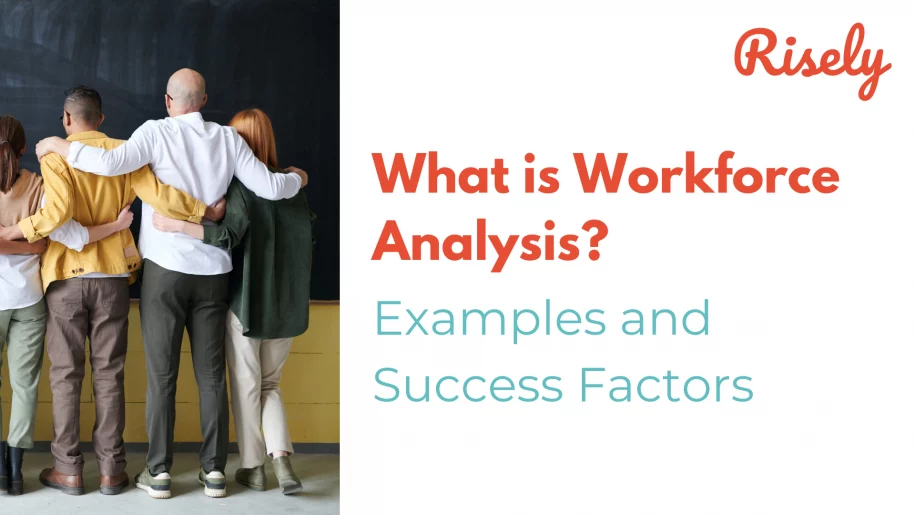What is Workforce Analysis? Examples and Success Factors
Workforce analysis is crucial for teams to optimize their workforce planning and management. It involves collecting and analyzing data related to employee skills, performance, demographics, and other factors to make informed decisions about hiring, training, and development. This blog will dive deep into what workforce analysis entails, the different types of studies that L&D managers can conduct, and the benefits it brings to organizations. We will also provide examples of how workforce analysis has been successfully applied in real-world scenarios and share best practices for its implementation. Additionally, we will explore the challenges faced in workforce analytics and discuss the differences between workforce analytics, people analytics, and HR analytics. Stay tuned as we uncover the latest trends in workforce analytics for 2023.- What is Workforce Analysis? Examples and Success Factors
- What is workforce analysis?
- Types of workforce analysis
- Benefits of workforce analysis
- Challenges of Workforce Analytics
- Applying workforce analysis
- Steps to introduce workforce analysis
- Workforce analysis success factors
- Workforce Analytics vs. People Analytics vs. HR Analytics
- Workforce analytics trends for 2023
- Conclusion
- Workforce Analytics FAQs
- Other Related Blogs
What is workforce analysis?
Workforce analysis examines and evaluates an organization’s workforce to gain insights into its composition, skills, capabilities, and overall effectiveness. It involves collecting and analyzing data related to employee demographics, performance, turnover, training needs, and other relevant factors. The purpose of workforce analysis is to inform decision-making and strategic planning related to talent management, succession planning, recruitment, training and development, and overall workforce optimization. Understanding the current state of the workforce and identifying areas for improvement or potential risks allows learning and development managers to make more informed decisions about effectively managing their human resources and achieving their business objectives. By the way, there’s a difference between strategic planning and strategic thinkin! Learn about it here: Strategic Thinking vs Strategic Planning: Which One Leads the Way to Success?Types of workforce analysis
Workforce analysis involves various types of analysis that organizations undertake to gain valuable insights into their workforce for strategic decision-making. These types include workforce planning analysis, skills gap analysis, diversity and inclusion analysis, succession planning analysis, workforce cost analysis, and performance analysis. Workforce planning analysis focuses on analyzing the present and future workforce needs, ensuring that the organization has the right talent at the right time. Broadly this exercise can be understood into three types:Predictive workforce analytics
Predictive workforce analytics is used by learning and development managers to forecast future workforce trends and outcomes. Leveraging historical data, statistical models, and machine learning algorithms helps managers anticipate future skill gaps, talent needs, and workforce performance. This analysis enables proactive decision-making in areas such as recruitment, training, and succession planning, allowing managers to make informed predictions about their workforce’s future composition and capabilities.Prescriptive workforce analytics
Prescriptive workforce analytics goes beyond prediction and provides learning and development managers with actionable recommendations to address workforce challenges. Combining predictive analytics with optimization techniques suggests specific interventions and strategies to optimize workforce performance. This analysis helps managers determine the most effective learning initiatives, talent development programs, or resource allocation decisions to achieve desired outcomes. It guides decision-making by offering data-driven insights on improving the efficiency, productivity, and skill levels of the workforce.Diagnostic workforce analytics
Diagnostic workforce analytics focuses on understanding the root causes of workforce issues and challenges. It involves analyzing historical and real-time data to identify patterns, trends, and anomalies that impact workforce performance. Learning and development managers use diagnostic analytics to investigate factors like employee engagement, training effectiveness, turnover rates, or performance gaps. By diagnosing the underlying causes of these issues, managers can design targeted interventions and make informed decisions to address specific problems and improve overall workforce effectiveness and satisfaction.Benefits of workforce analysis
Workforce analysis, also known as workforce analytics, delivers numerous benefits to organizations:- It allows L&D managers to identify skill gaps and areas for improvement within their workforce. Teams can pinpoint where additional training and development are needed by analyzing employee data, metrics, and analytics. This way, they can enhance employee competencies and ensure they have the right skills for current and future roles.
- Workforce analysis enables data-driven decision-making when it comes to recruitment, training, and employee development. By leveraging employee data and analytics, teams can make strategic choices that align with their talent management objectives. It leads to improved hiring, retention, and overall workforce productivity.
- Workforce analysis brings into focus workforce optimization and resource allocation. It helps learning and development managers align individual and strategic learning goals to create a cohesive strategy. This optimization can result in increased productivity and overall business outcomes.
Other Interesting Reads
Challenges of Workforce Analytics
When analyzing the workforce, organizations often encounter various challenges with workforce analytics. One of the foremost hurdles is ensuring the quality and accuracy of the data used for analysis. Reliable and up-to-date data is essential for making informed decisions. Privacy and security concerns surrounding sensitive employee data are also significant challenges. Organizations must navigate handling employee data with the utmost confidentiality. Additionally, integrating multiple data sources can prove complex, as it involves consolidating data from different systems to gain a holistic view of the workforce. Skilled analysts with the expertise to interpret and analyze data effectively are also critical for successful workforce analytics initiatives. L&D teams face another set of challenges to manage change and overcome resistance to change. Ensuring that insights derived from workforce analytics are implemented effectively is essential. Lastly, staying updated with the latest tools and technologies for practical analysis is crucial in keeping up with the evolving landscape of workforce analytics. Workforce analysis is an ongoing process that requires continuous monitoring and adaptation. Organizations must develop mechanisms to regularly collect, analyze, and update their workforce data to stay relevant and responsive to changing needs.Applying workforce analysis
Applying workforce analysis involves several vital steps to ensure its effectiveness. The first step is identifying and measuring key metrics related to recruitment, retention, performance, and employee engagement. Organizations can gain valuable insights into their workforce and identify areas for improvement. Workforce analysis helps make data-driven decisions regarding talent management, resource allocation, and strategic planning. By implementing best practices, such as regular data collection and benchmarking, L&D teams can track their progress and make informed decisions based on reliable workforce analytics. Applying workforce analysis is crucial in optimizing the workforce and driving business outcomes.Steps to introduce workforce analysis
- Set goals: The first workforce analysis step is identifying the business’s current needs. Understand the specific questions you want to answer or the problems you want to address through the analysis.
- Picturise the present scenario: Next, you must identify the skills and experience currently available within the workforce. Collect relevant data about your workforce from various sources, such as HR records, performance evaluations, training records, and employee surveys. Ensure data integrity and quality by validating and cleaning the data.
- Identify key metrics to study: Determine the key metrics and indicators that align with your objectives. Examples of metrics include employee turnover rate, skills gap analysis, training effectiveness, diversity ratios, and productivity metrics.
- Analyze the data: Analyze the findings of your data analysis and interpret what they mean for your organization. Look for areas of strength, opportunities for improvement, and potential challenges or risks. Once you understand your employees’ skills and experience, you can determine which positions should be replaced or upgraded with new technologies or methods.
- Plan your next steps: Based on the insights gained from the analysis, develop actionable recommendations to address workforce challenges or leverage opportunities. These recommendations should be aligned with the organization’s strategic goals and supported by data-driven evidence. It is essential to ensure the actions are communicated effectively with all the relevant stakeholders to gain buy-in and create impact.

Examples of Effective Use of Workforce Analytics
Example 1: Upskilling the existing team
L&D Manager: Sarah Scenario: Sarah, an L&D Manager in a software development company, conducts a workforce analysis and identifies a skills gap in her development team. The analysis reveals that the team lacks expertise in a specific programming language required for an upcoming project. Sarah decides to upskill the existing team members rather than hire new employees. Action Steps:- Training Needs Assessment: Identify specific training needs for the required skills.
- Training Program Development: Design a comprehensive training program.
- Training Delivery: Implement the program using various methods.
- Ongoing Support: Provide resources and mentorship during the learning process.
- Evaluation and Feedback: Monitor progress and measure the impact of the training.
Example 2: Hiring new team members
L&D Manager: John Scenario: John is an L&D Manager in a marketing agency and conducts a workforce analysis revealing a shortage of social media marketing expertise within the existing team. John decides to hire new team members to address this gap and meet the increasing demand for social media campaigns. Action Steps:- Job Analysis: Define the required skills and experience.
- Recruitment Strategy: Develop a targeted recruitment plan.
- Candidate Selection: Screen and interview candidates.
- Onboarding and Training: Provide onboarding and specialized training.
- Integration and Collaboration: Encourage teamwork and knowledge sharing.
- Performance Monitoring: Evaluate performance and provide feedback.
- Continuous Learning: Promote ongoing development and upskilling.
Workforce analysis success factors
Success factors in conducting workforce analysis involve:- Defining clear objectives and goals.
- Gathering relevant employee data.
- Analyzing trends and identifying gaps.
- Developing targeted strategies and action plans.
- Implementing and monitoring their effectiveness.
Workforce Analytics vs. People Analytics vs. HR Analytics
Workforce analytics, people analytics, and HR analytics are three distinct but overlapping disciplines used to analyze and improve various aspects of an organization’s workforce. The workforce analytics field primarily focuses on analyzing data related to employees, including their skills, performance, and productivity. On the other hand, people analytics takes a broader approach, encompassing the analysis of employee engagement, satisfaction, and well-being alongside the workforce data. HR analytics, as a specific branch, is dedicated to using data to analyze and improve HR processes and strategies such as recruitment, training, and performance management. By leveraging these analytics approaches, organizations gain actionable insights for making data-driven decisions and enhancing business outcomes.Workforce analytics trends for 2023
As we head into 2023, workforce analytics trends shape how organizations approach their talent management strategies. By embracing these trends and harnessing the power of workforce analytics, L&D managers can stay ahead in the competitive landscape.- AI and Machine Learning: Increasing adoption of AI and machine learning algorithms in workforce analytics, enabling more accurate predictions, prescriptive insights, and automation of data analysis processes.
- Predictive Workforce Planning: Teams use predictive analytics to forecast future workforce needs, including talent acquisition, skills gaps, and succession planning, to align with business goals and stay ahead of workforce challenges.
- Employee Experience Analytics: Analyze employee experience data to understand engagement, satisfaction, and well-being factors. Utilizing sentiment analysis, training feedback surveys, and social network analysis to identify drivers of employee experience and improve retention and productivity.
- Real-Time Workforce Monitoring: Continuous monitoring of workforce data and real-time analytics to identify patterns, trends, and anomalies as they happen. It allows L&D managers to promptly make agile and data-driven decisions to address emerging workforce issues.
- Diversity, Equity, and Inclusion (DEI) Analytics: Organizations leverage analytics to measure and improve diversity, equity, and inclusion initiatives. Data-driven insights help identify disparities, set targets, and track progress toward creating more inclusive and equitable workplaces.
- Skills and Learning Analytics: Analyzing data on employee skills, training programs, and learning outcomes to identify skill gaps, assess training effectiveness with relevant metrics, and personalize learning experiences. It helps organizations develop targeted upskilling and reskilling strategies.
- Ethical and Responsible Use of Workforce Data: Organizations are emphasizing ethical considerations and ensuring responsible use of workforce data. They are implementing policies and governance frameworks to protect employee privacy, data security, and transparency in analytics processes.
Conclusion
Workforce analysis is a powerful tool that allows organizations to make data-driven decisions regarding their workforce. By analyzing factors such as employee demographics, skills, performance, and engagement, workforce analysis provides valuable insights that can help optimize workforce planning, talent acquisition, and development strategies. By implementing effective workforce analysis practices, teams can improve productivity, reduce costs, enhance employee satisfaction, and drive business success. To learn more about the different types of workforce analysis and best practices for implementation, check out our blog. Stay ahead of the curve in 2023 by keeping up with the latest trends in workforce analytics.Can your plan your team’s strategy effectively?
Find out now with the free strategic thinking assessment for managers and leaders in just a few minutes.
Workforce Analytics FAQs
What is workforce analysis in management?
Workforce analysis in management involves evaluating an organization’s workforce to understand its composition and capabilities. It involves the use of data related to employee demographics, performance, turnover, training needs, and other relevant factors.
What is workforce analysis planning?
Workforce analysis planning uses these insights to develop strategies for managing the workforce. It includes taking care of the present and future workforce needs of the team.
Why is workforce analysis important?
Workforce analysis helps managers and decision-makers at many points. It is important for informed decision-making, talent management, succession planning, cost optimization, and risk management.
What are the 5 key elements of workforce planning?
The five key elements of workforce planning are demand analysis, supply analysis, gap analysis, action planning, and monitoring/evaluation. Demand analysis assesses future workforce requirements, supply analysis evaluates the current workforce, gap analysis identifies gaps, action planning develops strategies, and monitoring/evaluation ensures effectiveness and adaptability.
Other Related Blogs
Workforce Forecasting: How to Set the Team Right as an HR?
Workforce Forecasting: How to Set the Team Right as an HR? As an HR manager, one of your most crucial roles is ensuring your organization has a robust and efficient…
How To Effectively Manage Gen Z Employees At Work
How To Effectively Manage Gen Z Employees At Work As the workforce continues to change, so too does the way in which we need to manage our employees. And that…
7 Workplace Trends 2024 for Managers
7 Workplace Trends 2024 for Managers As 2024 has almost reached its mid, workplace trends are shaping to be quite interesting. From the rise of hybrid work to the increasing…


